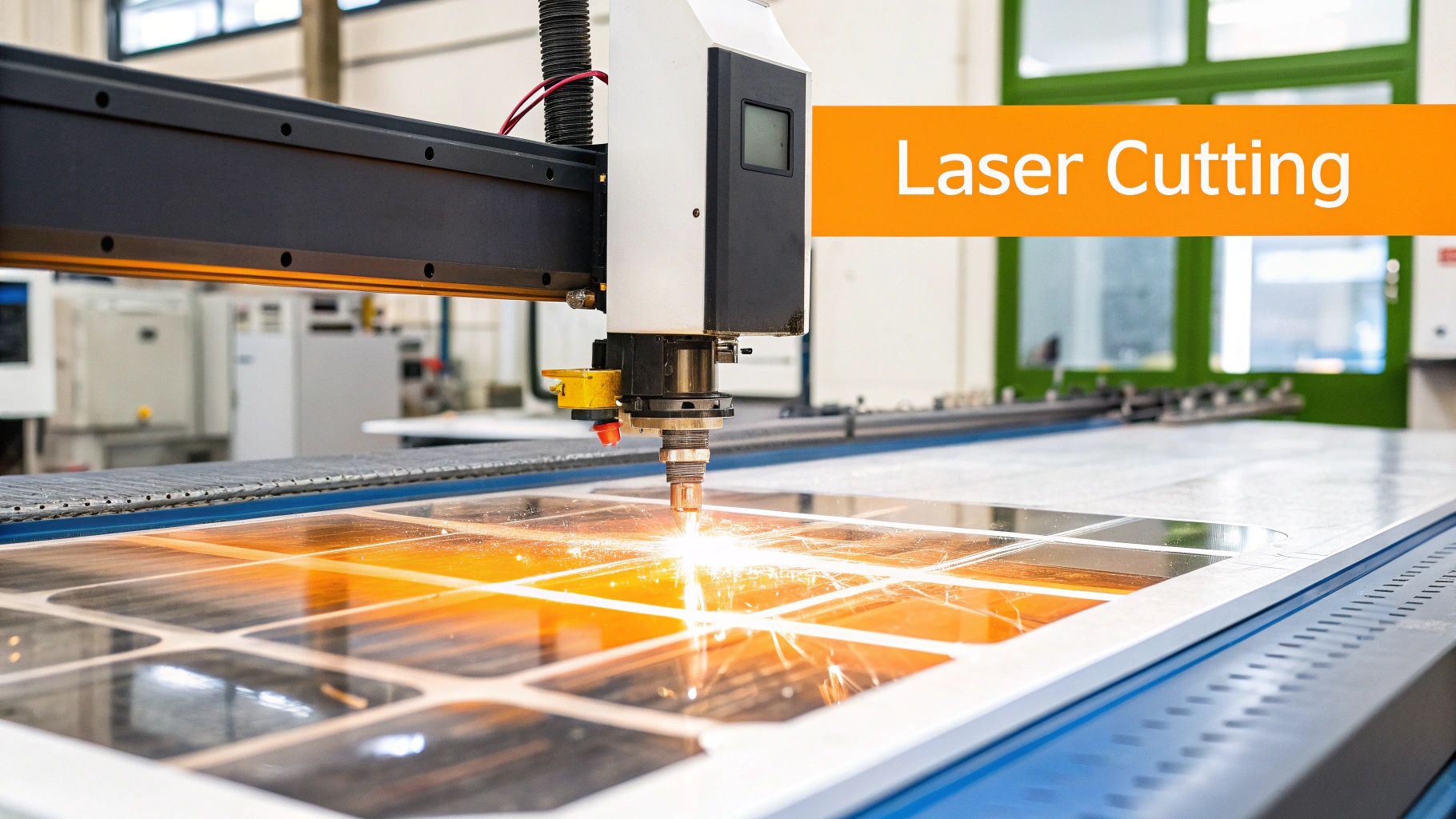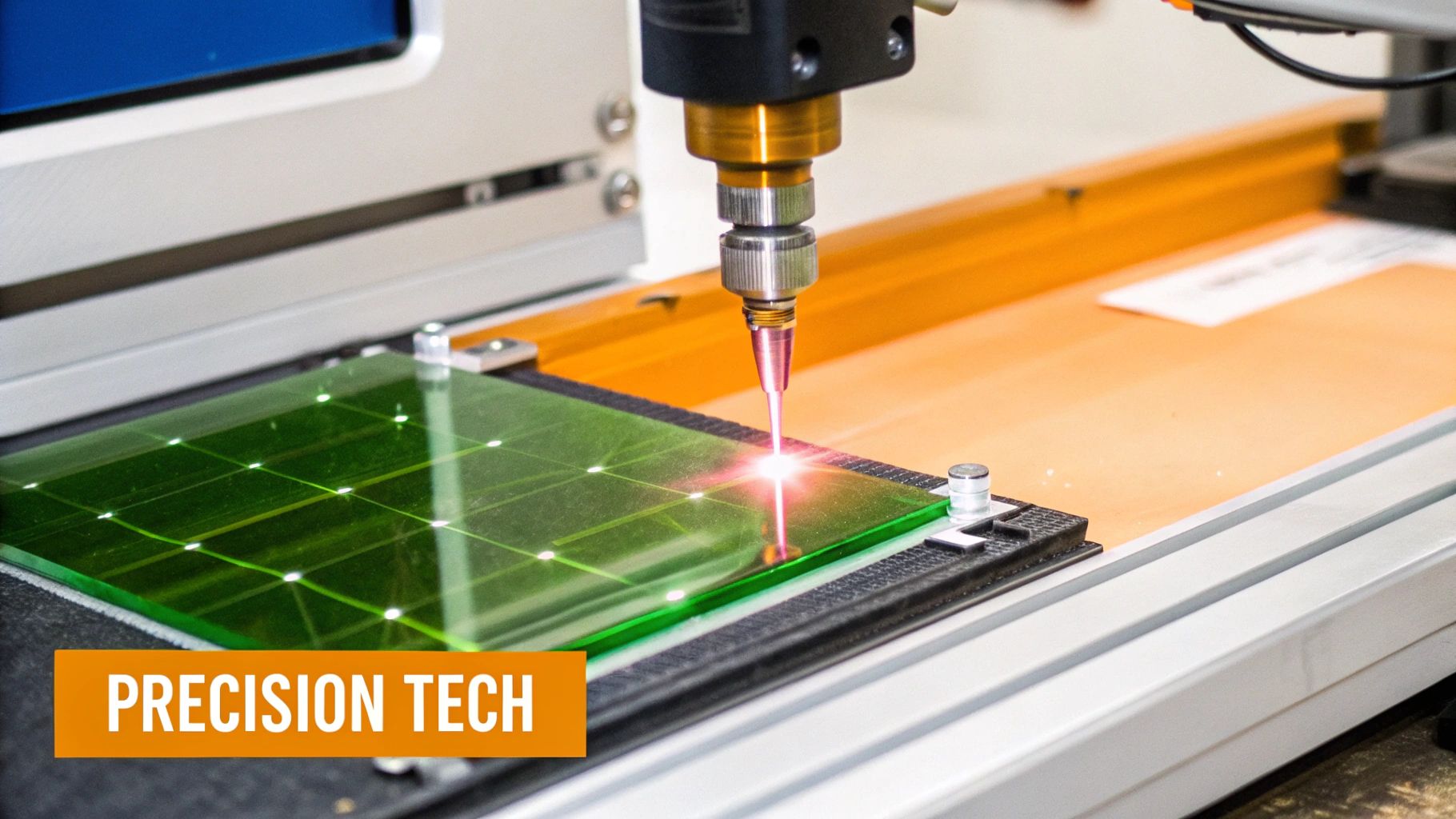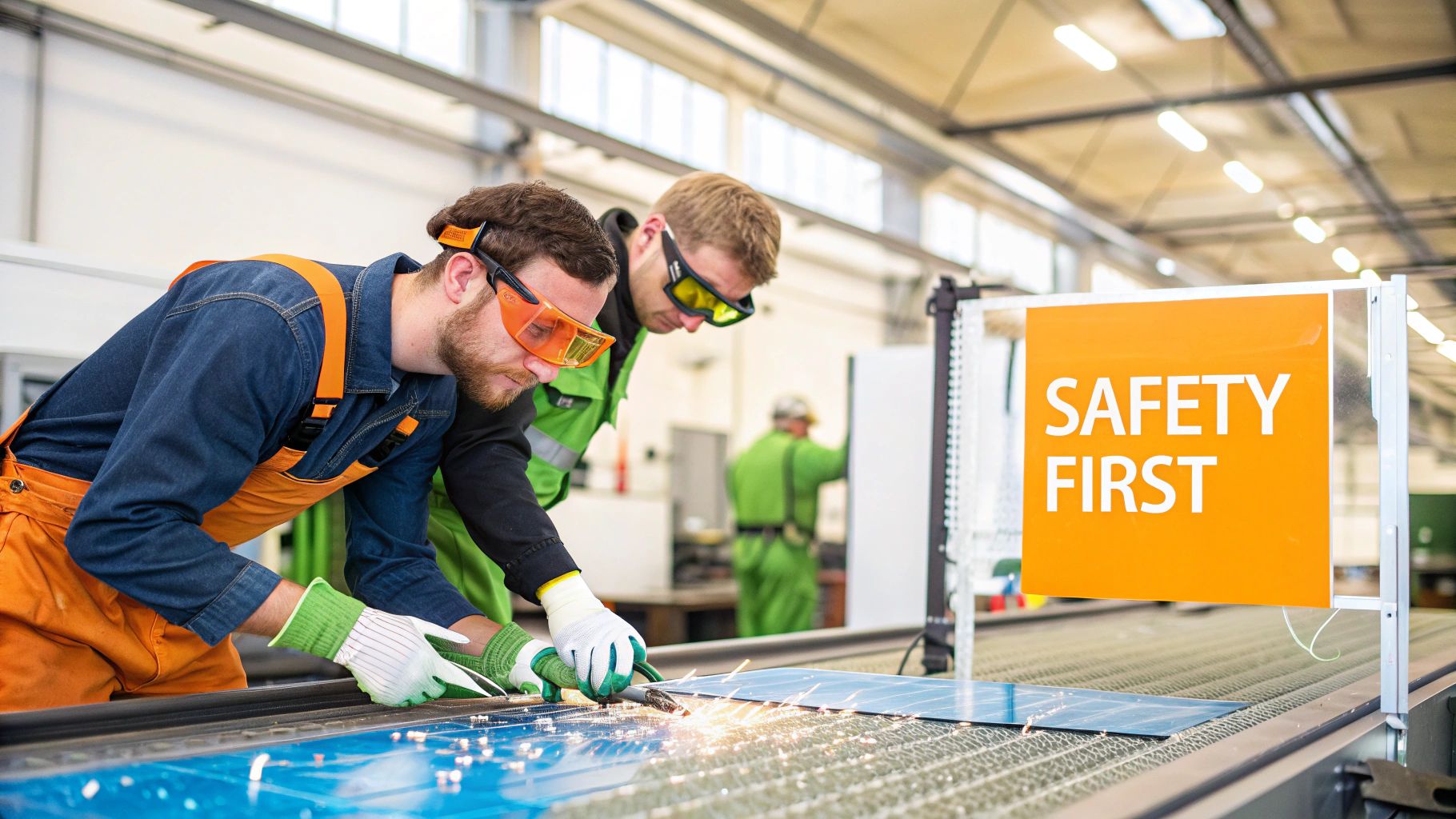L'evoluzione del taglio laser del vetro: da nicchia a necessità

Il taglio laser del vetro è passato da una tecnica specializzata a un processo industriale comune. Questo percorso evidenzia i notevoli progressi nella tecnologia laser. Inizialmente, le limitazioni di questa tecnologia, insieme alla difficile interazione tra laser e vetro, ne hanno ristretto l'uso a laboratori e applicazioni di nicchia. I primi sistemi di taglio laser erano spesso ingombranti, costosi e capaci solo di tagli di base.
I metodi tradizionali, spesso manuali, erano necessari per disegni intricati e lavori in vetro ad alta precisione. Tuttavia, la ricerca e lo sviluppo continui hanno progressivamente superato questi ostacoli iniziali.
Diversi fattori chiave hanno alimentato questa evoluzione. Lo sviluppo di sorgenti laser più potenti e precise, per esempio, ha portato a tagli più puliti e a velocità di lavorazione aumentate.
I progressi nei sistemi di controllo del fascio hanno anche migliorato significativamente la precisione. Questi sistemi permettono la creazione di geometrie sempre più complesse. Di conseguenza, il taglio laser può ora ottenere risultati precedentemente impossibili con i metodi tradizionali.
Inoltre, le tecniche raffinate di gestione dell'energia ottimizzano l'erogazione dell'energia del laser. Questa ottimizzazione si adatta a diversi tipi e spessori di vetro, minimizzando lo stress termico e prevenendo danni al delicato materiale vetroso.
Questi progressi non solo hanno migliorato la precisione e le capacità del taglio laser del vetro, ma hanno anche avuto un impatto profondo sul mercato. Il mercato globale del taglio laser del vetro ha visto una crescita rapida, diventando strategicamente importante nella produzione moderna. Nel 2023, il mercato è stato valutato nell'ordine di miliardi di dollari.
Si prevede che si espanderà a un tasso di crescita annuale composto (CAGR) di circa l'8% nei prossimi cinque anni. Questa crescita è alimentata dalla crescente domanda di tecnologie di taglio ad alta precisione, in particolare nel settore edilizio in espansione e nell'aumento della produzione di prodotti per la casa intelligente. Attualmente il Nord America guida il mercato, trainato da una forte domanda proveniente dai settori automobilistico ed elettronico, seguito da vicino dall'Europa e dalla regione Asia-Pacifico in rapida industrializzazione. Per statistiche più dettagliate, vedere le Note Applicative Sintec.
Traguardi Chiave nella Tecnologia di Taglio Laser del Vetro
- Fase iniziale: I sistemi di base con potenza e precisione limitate erano principalmente utilizzati per tagli e incisioni semplici.
- Fase Intermedia: I miglioramenti nelle sorgenti laser e nel controllo del fascio hanno permesso design più complessi e una lavorazione più veloce.
- Fase attuale: Laser altamente precisi e potenti facilitano ora tagli intricati, micro-lavorazioni e la lavorazione di un'ampia gamma di tipi e spessori di vetro.
Questa rapida evoluzione ha reso il taglio laser una tecnologia essenziale in diversi settori. Dai disegni intricati per il vetro architettonico alla produzione di componenti high-tech per l'elettronica, il taglio laser sta trasformando il modo in cui lavoriamo il vetro. La ricerca continua promette progressi ancora maggiori, spingendo i confini di questa straordinaria tecnologia.
Dietro il Raggio: Come Funziona Davvero il Taglio Laser del Vetro

Il taglio laser del vetro può sembrare incredibilmente complesso, ma il processo si basa su una fisica precisa. Questa sezione esplora l'interazione tra luce altamente focalizzata e vetro, rivelando la scienza dietro questa tecnica avanzata. Approfondiremo i principi fondamentali che regolano il taglio laser del vetro, come la dinamica termica, la frattura controllata e l'interazione con i materiali.
La fisica del taglio del vetro con il laser
Il processo inizia con un fascio laser altamente concentrato diretto sulla superficie del vetro. Questo fascio fornisce un'energia intensa a un'area piccola e precisa. L'interazione tra la luce laser e il vetro genera calore, aumentando rapidamente la temperatura nel punto focale.
Questo riscaldamento localizzato è cruciale per un taglio preciso. Immagina una lente d'ingrandimento che concentra la luce del sole per bruciare un pezzo di carta. Il principio è simile, ma il taglio laser offre una precisione e un controllo significativamente maggiori.
Questa energia concentrata porta a una frattura controllata, separando nettamente il vetro lungo il percorso designato. L'interazione tra il laser e il vetro dipende anche dalla lunghezza d'onda della luce. Alcune lunghezze d'onda vengono assorbite più efficacemente dal vetro, risultando in un taglio più efficiente. Altre potrebbero essere riflesse o trasmesse, rendendole meno adatte a questo scopo. Puoi trovare maggiori informazioni sulle tecniche laser su How to master....
Durata dell'impulso e tecniche di messa a fuoco
La durata dell'impulso del laser è un altro fattore vitale. Impulsi brevi forniscono raffiche intense di energia, perfette per dettagli fini e per minimizzare le zone influenzate dal calore. Impulsi più lunghi sono migliori per vetri più spessi o applicazioni dove la velocità è fondamentale.
Queste diverse durate dell'impulso influenzano la qualità del bordo del taglio, incidendo sulla sua liscezza e sulla potenziale formazione di microcrepe. Le tecniche di messa a fuoco utilizzate sono altrettanto cruciali.
La messa a fuoco precisa del fascio laser è essenziale per ottenere la corretta profondità e precisione del taglio. Vengono utilizzate diverse lenti di messa a fuoco e metodi in base all'applicazione specifica e al tipo di vetro. Il punto focale determina l'intensità dell'energia, influenzando direttamente la qualità del taglio.
Composizione del vetro e configurazione dell'apparecchiatura
La composizione del vetro stessa gioca un ruolo significativo. Alcune composizioni assorbono l'energia del laser più facilmente. Ciò significa che alcuni tipi di vetro sono più facili da tagliare con i laser, mentre altri possono richiedere attrezzature specializzate o parametri regolati. Le proprietà termiche dei diversi tipi di vetro influenzano anche la loro reazione al calore intenso del laser.
Per aiutare a illustrare i diversi tipi di laser utilizzati nel taglio del vetro, diamo un'occhiata al seguente confronto:
Tipi di laser per applicazioni di taglio del vetro
| Tipo di laser | lunghezza d'onda | Migliori applicazioni | Limitazioni | Costo relativo |
|---|---|---|---|---|
| Laser CO2 | 10,6 µm | Incisione, taglio di vetro più spesso | Precisione inferiore su vetro sottile | Moderare |
| Laser a fibra | 1,064 µm | Taglio di vetro sottile, alta precisione | Meno efficace su vetro più spesso | Più alto |
| Laser UV | 355 nm | Microlavorazione, bordi di alta qualità | Velocità di taglio inferiore | Più alto |
Questa tabella riassume le principali differenze tra i tipi di laser comuni utilizzati nel taglio del vetro, evidenziando i loro punti di forza e di debolezza in varie applicazioni. Come puoi vedere, la scelta del laser dipende fortemente dai requisiti specifici del progetto.
Infine, la configurazione dell'attrezzatura è cruciale per risultati ottimali. Attrezzature specializzate garantiscono un controllo preciso del fascio laser, del flusso del gas di assistenza e del movimento del vetro. I principali produttori migliorano continuamente le loro attrezzature per ottenere risultati sempre più impressionanti. Questa avanzata interazione tra laser e vetro consente applicazioni diverse ed espande le possibilità di questa tecnologia.
Perché il taglio laser del vetro supera i metodi tradizionali

L'uso del taglio laser per il vetro rappresenta un significativo allontanamento dai metodi tradizionali. Questo cambiamento è alimentato dalla necessità di una maggiore precisione, efficienza e miglioramento della qualità complessiva. Mentre le tecniche tradizionali di taglio del vetro consolidate spesso faticano a raggiungere i disegni intricati e le tolleranze strette richieste dalle applicazioni moderne.
Qualità superiore del bordo e riduzione degli sprechi
Uno dei maggiori vantaggi del taglio laser è la sua capacità di offrire una qualità del bordo superiore. I metodi tradizionali, come la rigatura e la rottura, spesso lasciano bordi ruvidi che richiedono un notevole lavoro di finitura secondaria. Il fascio concentrato di un laser, invece, crea un bordo straordinariamente pulito e liscio, eliminando spesso la necessità di ulteriori rifiniture.
Questo non solo fa risparmiare tempo, ma riduce anche al minimo gli sprechi di materiale. I metodi di taglio tradizionali possono produrre notevoli sprechi a causa di scheggiature e crepe. Il taglio laser riduce questi problemi, rendendolo un processo più attento alle risorse.
Eliminare l'usura degli utensili ed espandere le possibilità di progettazione
A differenza dei metodi tradizionali che si basano su strumenti fisici soggetti a usura, il taglio laser è un processo senza contatto. Questo elimina l'usura degli utensili, riducendo al minimo i tempi di inattività per manutenzione e sostituzione.
Il taglio laser offre anche un'eccezionale flessibilità di design. Geometrie complesse, motivi intricati e dettagli fini, un tempo difficili o impossibili da realizzare con strumenti tradizionali, sono ora facilmente ottenibili con la tecnologia laser. Questo apre nuove possibilità per design di prodotti innovativi e applicazioni in vari settori.
Maggiore sicurezza sul lavoro e benefici ambientali
Oltre ai vantaggi tecnici, il taglio laser offre miglioramenti sostanziali nella sicurezza sul lavoro. I metodi tradizionali spesso comportano la manipolazione di strumenti affilati e sostanze chimiche potenzialmente dannose, creando rischi per gli operatori. Il taglio laser, essendo un processo in gran parte automatizzato, riduce significativamente questi rischi.
Elimina anche la necessità di molti dei prodotti chimici aggressivi utilizzati nella tradizionale incisione e lavorazione del vetro. Questo crea un ambiente di lavoro più pulito e sicuro e riduce l'impatto ambientale legato allo smaltimento dei prodotti chimici.
Crescita del mercato e dipendenza dall'industria
Questo passaggio verso la tecnologia laser riflette una tendenza più ampia nell'automazione della produzione, migliorando sia l'efficienza che la qualità del prodotto. Il mercato delle macchine per il taglio laser sta vivendo una forte crescita, stimata a circa 7,12 miliardi di USD nel 2023 e prevista in crescita con un CAGR del 5,7% dal 2024 al 2030. Statistiche più dettagliate possono essere trovate qui. Questa crescita evidenzia la crescente dipendenza industriale dalle macchine per il taglio laser come parte vitale della produzione moderna, incluso il taglio laser del vetro.
Il Futuro del Taglio del Vetro
I vantaggi combinati di una migliore qualità del bordo, riduzione degli sprechi, flessibilità di progettazione e maggiore sicurezza sul posto di lavoro stabiliscono il taglio laser del vetro come un metodo superiore rispetto alle tecniche tradizionali. Permette ai produttori di sviluppare prodotti di maggior valore e ottenere un vantaggio competitivo. È evidente che il taglio laser non è semplicemente un miglioramento, ma un cambiamento fondamentale nel modo in cui processiamo e utilizziamo il vetro.
Trasformare le industrie: il vetro tagliato al laser in azione

Il taglio laser del vetro non è più un processo di nicchia limitato ai centri di ricerca. È ora una tecnologia fondamentale in diversi settori, spingendo i confini delle applicazioni del vetro. Questa esplorazione approfondisce gli usi pratici del vetro tagliato al laser, evidenziandone l'impatto su settori che vanno dall'architettura e l'automotive all'elettronica e oltre. Scopri maggiori dettagli sui progressi nel taglio laser del vetro in questa risorsa utile: laser cutting of glass advancements.
Vetro tagliato al laser nell'elettronica: la ricerca di un design elegante
La continua spinta del settore dell'elettronica verso design più piccoli e raffinati rende il vetro tagliato al laser una scelta perfetta. Questa tecnologia consente la produzione di schermi in vetro straordinariamente sottili ma resistenti per smartphone e tablet. La precisione dei laser crea ritagli intricati per pulsanti, fotocamere e sensori senza compromettere la resistenza complessiva del vetro.
Inoltre, il taglio laser consente di realizzare strutture interne complesse all'interno dei componenti in vetro. Ciò permette funzionalità avanzate come sensori tattili incorporati e strati di display sofisticati. La capacità di ottenere sia un design intricato che una costruzione robusta rende il taglio laser essenziale per l'elettronica moderna.
Meraviglie Architettoniche: Reinventare il Vetro nell'Edilizia
Il taglio laser sta rivoluzionando l'uso del vetro nell'architettura. Gli architetti possono ora progettare e realizzare caratteristiche complesse in vetro precedentemente impossibili da creare. Grandi facciate in vetro con motivi e texture intricati sono diventate realtà, migliorando l'estetica degli edifici e aumentando l'efficienza energetica attraverso la trasmissione controllata della luce.
La forza intrinseca e la precisione del vetro tagliato al laser contribuiscono significativamente all'integrità strutturale degli edifici moderni. Ciò consente strutture in vetro ampie che spingono i limiti del design edilizio tradizionale, creando vere e proprie meraviglie architettoniche innovative.
Precisione nei Dispositivi Medici: un'Applicazione Salvavita
Il campo dei dispositivi medici richiede un'estrema precisione, un requisito che il vetro tagliato al laser soddisfa facilmente. Questo metodo è essenziale per creare strumenti salvavita. I dispositivi microfluidici, utilizzati nei test diagnostici rapidi e nella medicina personalizzata, si basano sul taglio laser per i loro canali intricati e le dimensioni precise.
La capacità del taglio laser di creare componenti in vetro sterili e complessi è vitale per dispositivi impiantabili e strumenti chirurgici. Questa precisione contribuisce direttamente alla sicurezza del paziente e a migliori risultati medici, rendendo il taglio laser una tecnologia preziosa nel campo medico.
Automotive e Aerospaziale: Guidare l'Innovazione con il Vetro
Le industrie automobilistica e aerospaziale sfruttano le caratteristiche di leggerezza e alta resistenza del vetro tagliato al laser. Ciò si traduce in auto più leggere e a basso consumo di carburante con funzionalità avanzate come i display heads-up integrati nei parabrezza.
Nell'aerospaziale, componenti in vetro tagliati al laser specializzati migliorano le prestazioni degli aeromobili riducendo al minimo il peso. Questi componenti possono resistere a temperature e pressioni estreme, essenziali per la sicurezza e l'affidabilità dei complessi sistemi aerospaziali.
La tabella sottostante fornisce una panoramica delle applicazioni del vetro tagliato al laser in vari settori industriali. Evidenzia i requisiti specifici e il potenziale di crescita di questa tecnologia innovativa.
Applicazioni del vetro tagliato al laser in vari settori
| Industria | Applicazioni comuni | Requisiti Critici | Potenziale di crescita |
|---|---|---|---|
| Elettronica | Schermi per smartphone, sensori touch | Precisione, sottigliezza, durata | Alto |
| Architettura | Facciate, elementi di design d'interni | Geometrie complesse, resistenza, appeal estetico | Alto |
| Dispositivi medici | Dispositivi microfluidici, strumenti chirurgici | Sterilità, precisione, biocompatibilità | Alto |
| Automobilistico | Parabrezza, display a testa alta | Resistenza, chiarezza ottica, leggerezza | Moderare |
| Aerospaziale | Componenti specializzati, alloggiamenti per sensori | Resistenza alla temperatura, precisione, leggerezza | Moderare |
Questa tabella riassume le diverse applicazioni del vetro tagliato al laser e le esigenze uniche di ogni settore. L'elevato potenziale di crescita in molte aree sottolinea l'importanza crescente della tecnologia di taglio laser nel plasmare il futuro di queste industrie. I continui progressi nella tecnologia laser promettono applicazioni ancora più creative ed efficaci, portando a nuovi prodotti entusiasmanti e a prestazioni migliorate in diversi settori.
Il futuro del taglio laser del vetro
Il campo del taglio laser del vetro è in continua evoluzione. Spinto dalla necessità di una migliore precisione, velocità ed efficienza, stanno emergendo nuove tecnologie. Il design assistito dall'IA, per esempio, sta cambiando le regole del gioco.
Questa tecnologia consente di realizzare design in vetro incredibilmente intricati che prima erano impossibili. Ottimizzando i percorsi di taglio e minimizzando il materiale sprecato, il design assistito dall'IA permette di risparmiare denaro e apre a entusiasmanti possibilità di design.
Tendenze emergenti nel taglio laser del vetro
Sistemi di taglio laser multi-asse stanno diventando sempre più popolari. Questi sistemi tagliano il vetro da più angolazioni contemporaneamente, aumentando significativamente la velocità di produzione. Consentono anche tagli tridimensionali.
Questa capacità amplia le possibilità di creare forme complesse e disegni intricati nei componenti in vetro. Questi progressi stanno spingendo i limiti del taglio del vetro con il laser.
L'automazione industriale sta anche rimodellando il processo. I sistemi robotici sono ora frequentemente utilizzati per la manipolazione e il posizionamento del vetro durante il taglio. Questo migliora la precisione, riduce gli errori e permette agli operatori umani di concentrarsi su compiti più complicati. I sistemi automatizzati possono anche funzionare continuamente, aumentando la produzione e potenzialmente riducendo i costi.
Crescita del mercato e adozione regionale
L'adozione del taglio del vetro laser varia a livello globale. La regione Asia-Pacifico sta vivendo una rapida crescita della domanda, stimolata dall'industrializzazione e dai progetti infrastrutturali.
Tuttavia, altre regioni hanno un potenziale significativo di crescita non sfruttato. Questa distribuzione disomogenea presenta eccellenti opportunità per le aziende che cercano nuovi mercati.
Il mercato delle macchine per il taglio laser, comprese quelle per il vetro, è in forte espansione. Dal 2022 al 2023, il fatturato del mercato è cresciuto da 52,8 miliardi di USD a 57,4 miliardi di USD, con un CAGR dell'8,7%.
Questa crescita è prevista continuare, raggiungendo 102,9 miliardi di USD entro il 2030. Per statistiche più approfondite, visita: Statistiche sulle Macchine per Taglio Laser. Questa espansione riflette la crescente domanda di materiali per taglio laser come il vetro, guidata dalla necessità di precisione, velocità e riduzione degli sprechi.
Personalizzazione di massa e produzione su richiesta
Le tendenze manifatturiere più ampie stanno influenzando il futuro del taglio laser per il vetro. La personalizzazione di massa, che consente ai produttori di creare prodotti personalizzati su misura per le esigenze individuali dei clienti, sta diventando essenziale.
Il taglio laser, con la sua precisione e flessibilità, è perfettamente adatto a questa tendenza. Semplifica il processo di produzione di componenti in vetro unici in piccoli lotti.
Produzione su richiesta è un'altra tendenza in crescita. Questo modello minimizza i costi di inventario e consente alle aziende di rispondere rapidamente ai cambiamenti del mercato. Questo si allinea bene con le capacità del taglio laser, che può facilmente passare tra design e cicli di produzione. Leggi anche: Taglio laser e blog industriali per ulteriori approfondimenti.
Sostenibilità e il Futuro
Le iniziative di sostenibilità stanno assumendo un ruolo sempre più importante nell'avanzamento tecnologico. Il taglio laser, poiché riduce gli sprechi di materiale e il consumo di energia rispetto ai metodi tradizionali, contribuisce a una produzione più sostenibile.
Questo focus sulla responsabilità ambientale non sta solo guidando l'innovazione. Sta anche influenzando le scelte dei consumatori. Questa tendenza probabilmente continuerà, con continui progressi nella tecnologia laser mirati a minimizzare l'impatto ambientale della lavorazione del vetro. Ciò rafforza l'importanza del taglio laser come tecnologia vitale per il futuro della produzione.
Superare i limiti nel taglio laser del vetro
Il taglio laser del vetro offre un'incredibile precisione ed efficienza, ma come ogni tecnologia, ha le sue limitazioni. Comprendere queste sfide e come vengono affrontate è fondamentale per chiunque consideri questo processo all'avanguardia.
Barriere di Spessore e Compatibilità della Composizione
Una limitazione chiave è la barriera dello spessore. I laser tagliano facilmente lastre di vetro sottili con notevole precisione, ma i pezzi più spessi rappresentano una sfida. Tagliare vetro più spesso richiede un'energia significativamente maggiore, che può generare calore eccessivo, portando a crepe o altri danni. Inoltre, non tutte le composizioni del vetro reagiscono bene al taglio laser. Alcuni tipi, in particolare quelli con rivestimenti o materiali incorporati, possono comportarsi in modo imprevedibile sotto il calore intenso del laser.
Tuttavia, gli innovatori stanno affrontando questi problemi direttamente. Sono in fase di sviluppo sistemi di raffreddamento avanzati per minimizzare l'accumulo di calore durante il processo di taglio, permettendo la lavorazione di vetro più spesso.
Stanno emergendo anche lunghezze d'onda laser specializzate. Queste lunghezze d'onda sono progettate per essere assorbite in modo più efficace da specifici tipi di vetro, aumentando l'efficienza del taglio e riducendo lo stress termico. Ciò consente tagli più puliti e precisi su una gamma più ampia di composizioni del vetro.
Qualità del bordo e sfide geometriche
Un altro ostacolo è ottenere una qualità del bordo costante, specialmente con disegni intricati. Forme complesse e curve strette possono causare micro-fratture o bordi irregolari. Fortunatamente, i progressi nei sistemi di controllo del fascio stanno migliorando questo aspetto.
Un controllo più fine del fascio consente movimenti del laser incredibilmente precisi, minimizzando lo stress sul vetro e ottenendo bordi più lisci e di qualità superiore, anche in geometrie complesse. Sono inoltre in fase di sviluppo algoritmi software sofisticati per ottimizzare i percorsi di taglio, prevedendo e correggendo potenziali problemi di qualità dei bordi prima che si verifichino.
Considerazioni Economiche: Investimento, Energia e Formazione
L'investimento iniziale per le attrezzature di taglio laser può essere consistente, creando una barriera per alcuni. Il consumo energetico di questi potenti laser può inoltre aumentare i costi operativi. Inoltre, è generalmente necessaria una formazione specializzata per operare e mantenere questa complessa macchina, rappresentando un'altra spesa.
Ma i vantaggi a lungo termine possono superare questi costi iniziali. Maggiore efficienza, riduzione degli sprechi e qualità superiore del prodotto possono portare a risparmi significativi nel tempo. La capacità di creare design intricati e prodotti unici può anche aumentare la competitività sul mercato e la redditività.
Controllo Qualità e Rilevamento Difetti
Mantenere una qualità costante e identificare i difetti è essenziale in qualsiasi processo di produzione. Sebbene il taglio laser sia intrinsecamente preciso, possono comunque verificarsi piccole variazioni, spesso dovute a incoerenze nella composizione del vetro o a fluttuazioni nella potenza del laser.
Gli specialisti del controllo qualità stanno sviluppando metodi avanzati per monitorare e affrontare queste variazioni. I sensori in tempo reale possono rilevare cambiamenti nell'uscita del laser durante il taglio, consentendo aggiustamenti immediati per garantire una qualità costante. Vengono inoltre impiegati sistemi di imaging avanzati per rilevare micro-fratture e altri difetti sottili invisibili a occhio nudo.
Direzioni di ricerca promettenti e soluzioni emergenti
La ricerca in corso promette entusiasmanti progressi nel taglio laser del vetro. Questo include sistemi alimentati da AI che automatizzano i parametri di taglio e ottimizzano sia l'efficienza che la qualità.
I ricercatori stanno anche esplorando nuovi materiali e tecniche per migliorare l'interazione tra la luce laser e il vetro. Queste innovazioni potrebbero portare a velocità di taglio più elevate, qualità dei bordi superiore e la capacità di lavorare strutture in vetro ancora più spesse e intricate. Questi sviluppi ampliano continuamente le possibilità del taglio laser del vetro, sbloccando nuove applicazioni in vari settori. Per approfondimenti sulla tecnologia laser, visita Laser Insights China. Questa risorsa fornisce informazioni preziose sulle applicazioni laser, inclusi taglio, saldatura e pulizia, offrendo guide tecniche e interviste con esperti.

